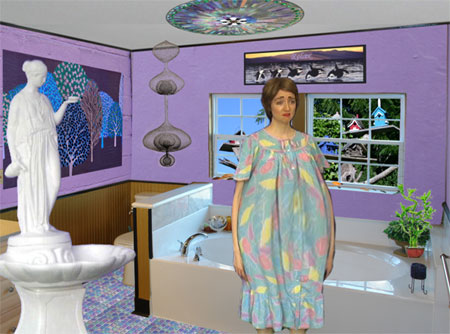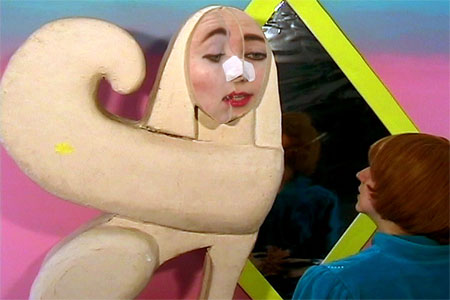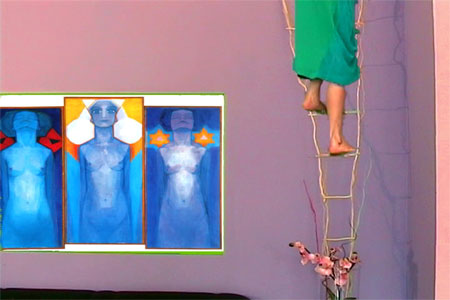
Found objects have had a place in art for nearly a century, but the practice has seemed particularly pervasive in recent years, as approaches from both contemporary and historical perspectives have attempted to redefine it as appropriation, nonmonumental, unmonumental, or "combining crap with crap." Fascination with old or overlooked marginalia could be regressive melancholia spawned of the Bush era's resigned cynicism, or sympathy for the poor objects in spite of high-tech consumption. Whatever the case, the sensibility saturates Shana Moulton's Whispering Pines, a series of videos and performances. While sculptural assemblage clusters objects in space, Moulton spreads her thrift-store and gift-shop finds over time. Rather than tracing the artist's web of references through stationary contemplation, the viewer of Whispering Pines is led through the process as Cynthia, the heroine, interacts with the things she has chosen to surround herself with. A Magic Eye 3D poster transports her to a zone of free movement. A swamp-colored facial mask opens a green-screen gateway to a forest clearing. If, in a readymade or sculptural assemblage, the artist endows objects with totemic power by isolating and emphasizing their formal properties (or the subjective associations they evoke for her), then Moulton gives that principle a radically literal interpretation in Whispering Pines, where objects' properties and associations acquire the power to shape the narrative.
Moulton gets inspiration for episodes from her finds rather than "casting" them in predetermined storylines. Objects drive the plot. Wonder at a thing's appearance can be a narrative hook that doubles as a more conventional dilemma, and ultimately offers a key to an episode's insight. At the beginning of Whispering Pines 3, Cynthia is composing a diary entry about her runaway cat and a newly acquired knickknack that baffles her with its twisted script. "I found a wonderful wall hanging today," she says in a voiceover. "I really like its texture. But I can't understand what it is trying to say." Next Cynthia is in a forest, chasing her cat with a butterfly net, when she spots her wall hanging, turned on its end in the gnarl of a tree. Cocking her head, she can suddenly read it: "Towels?!" Back in her armchair, Cynthia fingers a plush cat's head nestled in her collar as she sits beneath the "Towels" sign. She's content. But the viewer feels uneasy. Did Cynthia ever have a cat? Or did she misplace a toy that she equates with the living thing it represents? And now that she knows what the wall hanging says, shouldn't she put it where it presumably belongs--above a towel rack? Consideration of the wall hanging leads to a conclusion of its ridiculous redundancy--it's a sign meant to index a nearby object that can easily be identified by its appearance, while the sign itself is ornate to the point of illegibility. The real referent of the "Towels" sign is not towels, but domestic comfort. Moulton arrives at this idea by giving the wall hanging the power to send Cynthia home, and matching it to the cozy act of stroking a pet--even as she retains the aura of strangeness around it with the abrupt cut from forest to house, and the unsettling sight of Cynthia nuzzling a disembodied stuffed animal.
-->-->
In one interview, Moulton said her tutors at De Ateliers in Amsterdam asked her if she was trying to make children's television. Indeed, the flashes of magic in a pastel-hued, innocuous suburban setting give Whispering Pines a faint resemblance to late-twentieth century escapist fantasies for tweens --"Out of This World" and "Sabrina, the Teenage Witch" come to mind. Those heroines, however, deployed supernatural powers to fix problems with boys, friends, and parents, whereas Cynthia exists in a social vacuum. Her concerns are limited to her problems and her belongings, and the latter, not Cynthia, possess the magic. Whispering Pines blends Nickelodeon abracadabra with the consumer's faith that purchases--home decor, skin care products, self-help books--will make life better and happier. But, as Cynthia's mute bewilderment reminds us, agency lies in the objects, and the results are never what Cynthia or the viewer might expect -- like the off-brand pore-cleansing strips that conjure a singing Sphinx in the bathroom mirror. And for all her attempts to improve her life, Cynthia, like a sitcom character, registers no net change from episode to episode (a fact reinforced by the non-chronological numeric sequence of some episodes). Sure, the products aren't all they're cracked up to be, but this is far from a critique of the market and its sham promises. It's just a way to keep the slate blank for further explorations of the subject's relation to her surroundings.
Perhaps because plot points bring changes in Cynthia's environment, those writing about Whispering Pines have sometimes described them as moments of fluctuation between reality and fantasy. But can we really call the settings that bookend an episode "reality" just because they look like a house, and thus fit easily into a familiar there-and-back-again narrative structure that would make Cynthia yet another Alice or Dorothy? What kind of reality is it if a woman wears a hemorrhoid cushion in her dress? Variations in the videos' visual texture also suggest a greater complexity. After composing a floral arrangement from Crystal Light beverage powder and plastic branches in Whispering Pines 8, Cynthia ascends a ladder that sprouts from it, like Jack climbing his beanstalk, to a rave. What she finds there isn't a fairy tale, but the closest Whispering Pines gets to cinéma vérité: a poorly lit warehouse with spirited dancing. The soundtrack also gets more "real": A full-bodied remix of Enya's "Orinoco Flow" replaces the thin MIDI version of it that accompanied Cynthia's home floral arranging. There are no constant visual codes. In Whispering Pines 9, even as Cynthia sits at home watching television, she is green-screened into the setting (the shimmering contour of her body gives it away), just as she was in the mystical cat-hunt scene in Whispering Pines 3 described above. The action in Whispering Pines isn't split neatly into dreaming and waking, although there are often straightforward suggestions of those activities. Instead, it's a single, rippled reflection of our reality, and how objects, media, images, and ideas bleed together in ways that cannot be accounted for by obsolete--but still often invoked--categories of the "real" and the "virtual."
"I am more than my physical body. I am limitless," intones an audio book that Cynthia listens to in Whispering Pines 4. The storylines and visual effects of Whispering Pines visualize relations where an object, an image of it on paper or a screen, a memory of it or an idealized notion of it share equal standing in a subject's perception. That philosophy is realized largely through the use of readymades, but editing and narrative add dimensions beyond the scope of sculptural assemblage. The mobility of video circumvents the white cube's isolation to allow for diverse viewing environments (some episodes of Whispering Pines, by the way, can be viewed here, here, and here), while the prominence of found objects, with their recognizable grain of off-screen existence, mean Whispering Pines isn't a detached, external representation of our reality, but an extension of it.

These ideas were strikingly manifest in a performance Moulton gave last fall at Art in General. After an attempt to imitate the elegant, dark-skinned women on TV by balancing a jug on her head ended in shattered pottery, Cynthia danced beneath highly ornate pots that floated as projections on the screen above her head. Then she vanished behind a curtain, as a video projection told the rest of the story. Audiences have another chance to see Cynthia on stage this weekend, when Whispering Pines 10 premieres at The Kitchen. Perhaps Moulton's most ambitious project yet, the new installment of the series is an opera conceived and created in collaboration with Nick Hallett, a composer, musician, and curator. To complement Moulton's videos and sets and Hallett's score (with singers vocalizing Cynthia's internal monologues), Whispering Pines 10 involves interactive sound objects that the collaborators devised during a Harvestworks residency. Skechers Shape-ups, wired to produce sound, will expand the Whispering Pines repertoire of objects enhanced to reveal the layers of being beyond their physical shape.

